INSTITUT SUPERIEUR D'ANTHROPOLOGIE
INSTITUTE OF ANTHROPOLOGY
ONLINE COURSES / COURS A DISTANCE
INSCRIPTION 2012 / Session II : Avril 2012
REGISTRATION 2012 / Term II : April 2012
GUADELOUPE – 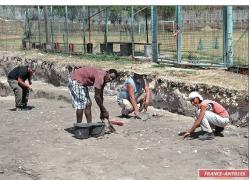 Capesterre - Une fouille archéologique préventive est en cours autour du terrain de football du stade municipal José-Bade de la commune de Capesterre. Cette fouille fait suite à un diagnostic archéologique réalisé en 2010 par l'Inrap, à la demande de la municipalité, en prévision de l'installation de nouveaux équipements (tribunes, vestiaires) sur le pourtour du terrain et compte-tenu de l'existence de vestiges amérindiens sur les parcelles voisines. Ce diagnostic avait confirmé la présence de riches vestiges amérindiens. Ces éléments du patrimoine risquant d'être affectés par les nouvelles constructions, une prescription de fouille archéologique a dû être émise, à la suite du diagnostic. La fouille a commencé à la mi-février et sera menée jusque début mars par cinq archéologues de l'Inrap. Nathalie Serrand est en charge des opérations : « Dès les années 1970, le père Barbotin faisait référence au site et décrivait l'existence, au niveau du stade municipal de Capesterre, de vestiges amérindiens s'étendant sur près d'un demi-hectare, entre le morne Pierre Claire et la mer. Toutefois aucune fouille majeure n'avait été réalisée. En 2002, une fouille préventive avait été menée dans la parcelle voisine, à l'occasion de la construction d'une résidence hôtelière. Deux dépotoirs amérindiens avaient été découverts : l'un, ancien, à la base du morne, attribué à la phase amérindienne cedrosan-saladoïde, aux alentours de 250-780 ap. J.-C. et un second, vers la mer, attribué à une phase amérindienne plus tardive, troumassoïde, vers 500-600 ap. J.-C. » Les fouilles en cours autour du terrain de football ont permis de retrouver d'autres vestiges de ces deux occupations principales et compléteront les connaissances sur ce village amérindien majeur. Ces vestiges sont parfaitement bien conservés et donnent des renseignements sur les activités quotidiennes des occupants au cours du temps : reliefs de repas (coquillages, ossements de poissons, de petits rongeurs), fragments de vaisselle en terre cuite portant des décors élaborés, vestiges des creusements des poteaux des carbets, sépultures, etc. Le site de Tourlourous, dont une portion se trouve sous le stade municipal, s'inscrit dans une zone de forte occupation amérindienne qui s'étend sur toute la plaine littorale de Capesterre et présente un intérêt majeur pour la connaissance de ces cultures. Ces éléments sont fouillés et documentés sur place afin de recueillir le maximum d'informations. La municipalité pourra ensuite démarrer la construction des nouveaux équipements du stade. Les vestiges continueront à être étudiés hors site afin de mieux comprendre la vie quotidienne de ces Amérindiens.
Capesterre - Une fouille archéologique préventive est en cours autour du terrain de football du stade municipal José-Bade de la commune de Capesterre. Cette fouille fait suite à un diagnostic archéologique réalisé en 2010 par l'Inrap, à la demande de la municipalité, en prévision de l'installation de nouveaux équipements (tribunes, vestiaires) sur le pourtour du terrain et compte-tenu de l'existence de vestiges amérindiens sur les parcelles voisines. Ce diagnostic avait confirmé la présence de riches vestiges amérindiens. Ces éléments du patrimoine risquant d'être affectés par les nouvelles constructions, une prescription de fouille archéologique a dû être émise, à la suite du diagnostic. La fouille a commencé à la mi-février et sera menée jusque début mars par cinq archéologues de l'Inrap. Nathalie Serrand est en charge des opérations : « Dès les années 1970, le père Barbotin faisait référence au site et décrivait l'existence, au niveau du stade municipal de Capesterre, de vestiges amérindiens s'étendant sur près d'un demi-hectare, entre le morne Pierre Claire et la mer. Toutefois aucune fouille majeure n'avait été réalisée. En 2002, une fouille préventive avait été menée dans la parcelle voisine, à l'occasion de la construction d'une résidence hôtelière. Deux dépotoirs amérindiens avaient été découverts : l'un, ancien, à la base du morne, attribué à la phase amérindienne cedrosan-saladoïde, aux alentours de 250-780 ap. J.-C. et un second, vers la mer, attribué à une phase amérindienne plus tardive, troumassoïde, vers 500-600 ap. J.-C. » Les fouilles en cours autour du terrain de football ont permis de retrouver d'autres vestiges de ces deux occupations principales et compléteront les connaissances sur ce village amérindien majeur. Ces vestiges sont parfaitement bien conservés et donnent des renseignements sur les activités quotidiennes des occupants au cours du temps : reliefs de repas (coquillages, ossements de poissons, de petits rongeurs), fragments de vaisselle en terre cuite portant des décors élaborés, vestiges des creusements des poteaux des carbets, sépultures, etc. Le site de Tourlourous, dont une portion se trouve sous le stade municipal, s'inscrit dans une zone de forte occupation amérindienne qui s'étend sur toute la plaine littorale de Capesterre et présente un intérêt majeur pour la connaissance de ces cultures. Ces éléments sont fouillés et documentés sur place afin de recueillir le maximum d'informations. La municipalité pourra ensuite démarrer la construction des nouveaux équipements du stade. Les vestiges continueront à être étudiés hors site afin de mieux comprendre la vie quotidienne de ces Amérindiens.
http://www.guadeloupe.franceantilles.fr/regions/marie-galante/le-stade-devoile-ses-tresors-archeologiques-03-03-2012-160687.php
ROYAUME UNI – 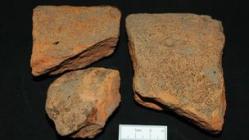 Carzield Roman Fort - A series of Roman artefacts has been found during works to install a water main through a former fort site. The discovery was made as work was carried out at Wellington Bridge near Kirkton in Dumfries and Galloway. Archaeologists supervised the Scottish Water works through the site of the Carzield Roman Fort. Items discovered included Roman tiles, clay fragments and pieces of cast iron metalwork which will now be taken for analysis and carbon dating. John Atkinson, of GUARD Archaeology, said: "A series of archaeological features were uncovered during the work, which appear to correlate with the projected layout of Carzield Roman Fort as witnessed during previous investigations. "These features included the remains of four separate areas of cobbled surface, three of which coincide with the position of a projected barrack block on the south-west edge of what would have been the main Roman road through the fort. "The most north-westerly of the surfaces lay within what would have been the central area of the fort and appeared to be more refined in its construction. "Below the surfaces there were two ditch features extending north-west and south-east." Further analysis should allow the origin of the artefacts to be better understood and allow "detailed insight" into life in the area during Roman times or possibly earlier.
Carzield Roman Fort - A series of Roman artefacts has been found during works to install a water main through a former fort site. The discovery was made as work was carried out at Wellington Bridge near Kirkton in Dumfries and Galloway. Archaeologists supervised the Scottish Water works through the site of the Carzield Roman Fort. Items discovered included Roman tiles, clay fragments and pieces of cast iron metalwork which will now be taken for analysis and carbon dating. John Atkinson, of GUARD Archaeology, said: "A series of archaeological features were uncovered during the work, which appear to correlate with the projected layout of Carzield Roman Fort as witnessed during previous investigations. "These features included the remains of four separate areas of cobbled surface, three of which coincide with the position of a projected barrack block on the south-west edge of what would have been the main Roman road through the fort. "The most north-westerly of the surfaces lay within what would have been the central area of the fort and appeared to be more refined in its construction. "Below the surfaces there were two ditch features extending north-west and south-east." Further analysis should allow the origin of the artefacts to be better understood and allow "detailed insight" into life in the area during Roman times or possibly earlier.
http://www.bbc.co.uk/news/uk-scotland-south-scotland-17237825
ROYAUME UNI – 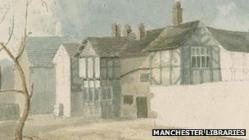 Hulme - Manchester Metropolitan University is holding a public archaeology dig on the site of its new campus. The team, at Birley Fields in Hulme, is trying to find the remains of a medieval farm and the foundations of terraced houses built during the Industrial Revolution. Dr Simpson said the earliest survey of Hulme is a map from 1786 that marks Hulme Hall on the south-western fringe of Manchester and farmsteads including Hulme Farm and Jackson's Farm. The excavation is targeting the site of Jackson's Farm and the houses that occupied the site from the later 19th Century, as well as the site of Holy Trinity Church.
Hulme - Manchester Metropolitan University is holding a public archaeology dig on the site of its new campus. The team, at Birley Fields in Hulme, is trying to find the remains of a medieval farm and the foundations of terraced houses built during the Industrial Revolution. Dr Simpson said the earliest survey of Hulme is a map from 1786 that marks Hulme Hall on the south-western fringe of Manchester and farmsteads including Hulme Farm and Jackson's Farm. The excavation is targeting the site of Jackson's Farm and the houses that occupied the site from the later 19th Century, as well as the site of Holy Trinity Church.
http://www.bbc.co.uk/news/uk-england-manchester-17244162
EGYPTE – 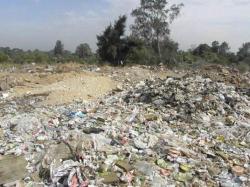 Abousir - Since last January’s uprising, the archaeologically rich area of Abu Sir in the Giza Governorate has come to resemble an ad hoc garbage disposal site due to a lack of law enforcement coupled with an ongoing conflict between the army, a nearby sand quarry and a garbage dump, residents say. The governorate’s garbage dump site is situated several kilometers into the desert at the end of a road that also leads to a sand quarry, near the Beni Yusef army base. However, due to a lack of law enforcement and police presence, the garbage trucks no longer deposit at the dump site regularly, dumping the garbage in the nearby canals, throughout the desert, and among the area’s archaeological sites instead. The Abu Sir sand quarry has, according to residents, been digging outside its property for years, crossing the restrictive lines put in place by the Ministry of State for Antiquities Affairs. The same location was reported to have fallen victim to archaeological theft and looting during the 2011 protests earlier last year. Residents say that this looting and digging for antiquities has never stopped and now involves many of the quarrymen.
Abousir - Since last January’s uprising, the archaeologically rich area of Abu Sir in the Giza Governorate has come to resemble an ad hoc garbage disposal site due to a lack of law enforcement coupled with an ongoing conflict between the army, a nearby sand quarry and a garbage dump, residents say. The governorate’s garbage dump site is situated several kilometers into the desert at the end of a road that also leads to a sand quarry, near the Beni Yusef army base. However, due to a lack of law enforcement and police presence, the garbage trucks no longer deposit at the dump site regularly, dumping the garbage in the nearby canals, throughout the desert, and among the area’s archaeological sites instead. The Abu Sir sand quarry has, according to residents, been digging outside its property for years, crossing the restrictive lines put in place by the Ministry of State for Antiquities Affairs. The same location was reported to have fallen victim to archaeological theft and looting during the 2011 protests earlier last year. Residents say that this looting and digging for antiquities has never stopped and now involves many of the quarrymen.
http://www.egyptindependent.com/node/681041
ROYAUME UNI - Hoppen Hall farm - A major project is to track back over the last 10,000 years of change in a slice of the Northumbrian landscape. Archaeologists will lead a community programme which will explore the natural and human-use history of a 2km sq wetland site at Hoppen Hall farm, near Lucker. After the last Ice Age, the area was a series of inland lakes and islets, which attracted Stone Age hunters. Although lakes were still recorded on 18th Century maps, they have silted up and the main landscape feature today is Newham peat bog. The plan is to select the most promising location for a summer dig at the site, which is in the hinterland of Bamburgh Castle. The kaims are glacial ridges of high ground, among which the lakes formed and drained into Budle Bay. The project has taken the first peat core samples, from which trapped pollen will provide answers to what trees and plants grew on the land over thousands of years. Evidence suggests that there was prehistoric and medieval settlement. A trial dig has unearthed a stone hearth which has been dated to 4,000 to 4,500 years ago in the Middle Stone Age, and which would have been located on the shore of one of the lakes.
http://www.journallive.co.uk/north-east-news/environment-news/2012/03/03/what-happened-as-the-lakes-made-their-slow-retreat-61634-30449806/
ROYAUME UNI – 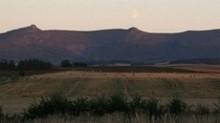 Bennachie - Experts from the University of Aberdeen have received new funding to create a heritage project for Bennachie and the surrounding landscape. The initial aim for archaeologists will be to gain new insights into a 19th century settlement of farming families, known as 'the colony' which lived on Bennachie from the 1830s.
Bennachie - Experts from the University of Aberdeen have received new funding to create a heritage project for Bennachie and the surrounding landscape. The initial aim for archaeologists will be to gain new insights into a 19th century settlement of farming families, known as 'the colony' which lived on Bennachie from the 1830s.
http://news.stv.tv/scotland/north/299604-archaeologists-to-shed-new-light-on-popular-north-east-landmark/
INDE - Vadali - Archaeological Survey of Gujarat hopes to find remains of centuries old civilization that may have once thrived at Vadali near Patan in north Gujarat. "A four member team will begin excavation at the site from Monday. The excavation work would continue for at least three months," superintending archaeologist Hitesh Shah said. "Earlier, we had found a small Buddhist Vihara (monastery) at Vadnagar. During our work here I found enough clues that suggested that the site had many ancient monuments," Shah added. "Patan has history that goes past several hundreds of years. It has a distinct character and the archaeological sites found at Patan are indeed very rare," said Gujarat State Archaeology superintendent Dr Yadubirsingh Rawat.
http://timesofindia.indiatimes.com/city/rajkot/Excavation-to-begin-at-Vadali/articleshow/12129833.cms